It's 5 a.m. in Arizona , which equates to 4:00 a.m. PST, 7 a.m. EST, and 6 a.m. CST. This puts me close enough to the middle of the launch of the annual shopping feeding frenzy that I'm unofficially ringing the bell, and calling this the online observer's start of what we've all been schooled to know as "Black Friday," the biggest shopping day of the year for retailers and consumers alike. While traditionally an in-store experience, more and more retailers are bringing Black Friday online, not only advertising promotions occurring at their brick and mortar locations, but also fishing for sales through their web stores. Let's see what's happening at this early hour, shall we?
Examining PPC, or Pay-Per-Click, activity is always a good way to get a quick lay of the land. Paying for a phrase is an important indicator of corporate level interest as there's a financial investment attached, all be it relatively small, and not necessarily an indicator of true revenue production as we can only see the ad and its placement, not its conversion through this lens. None the less, looking at the term "Black Friday" we see the following:
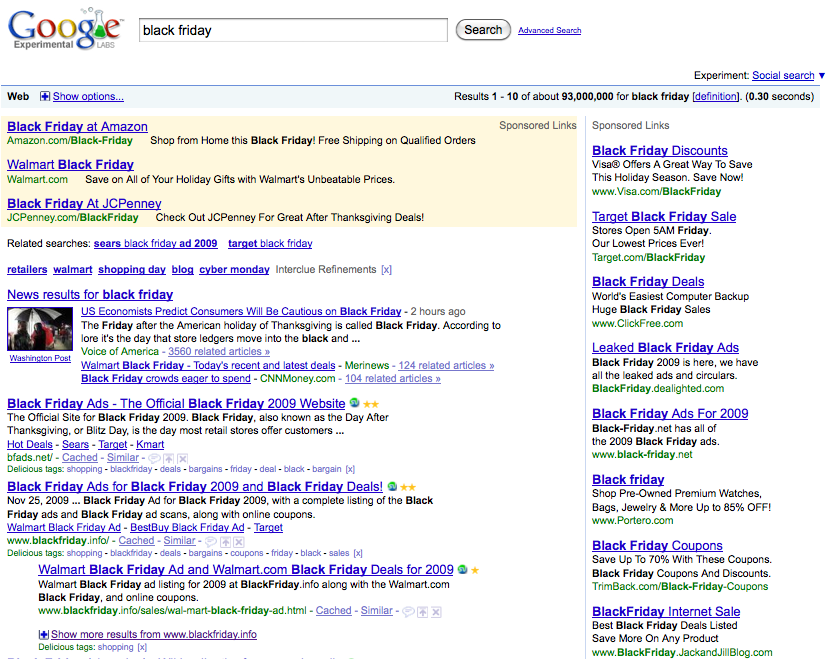
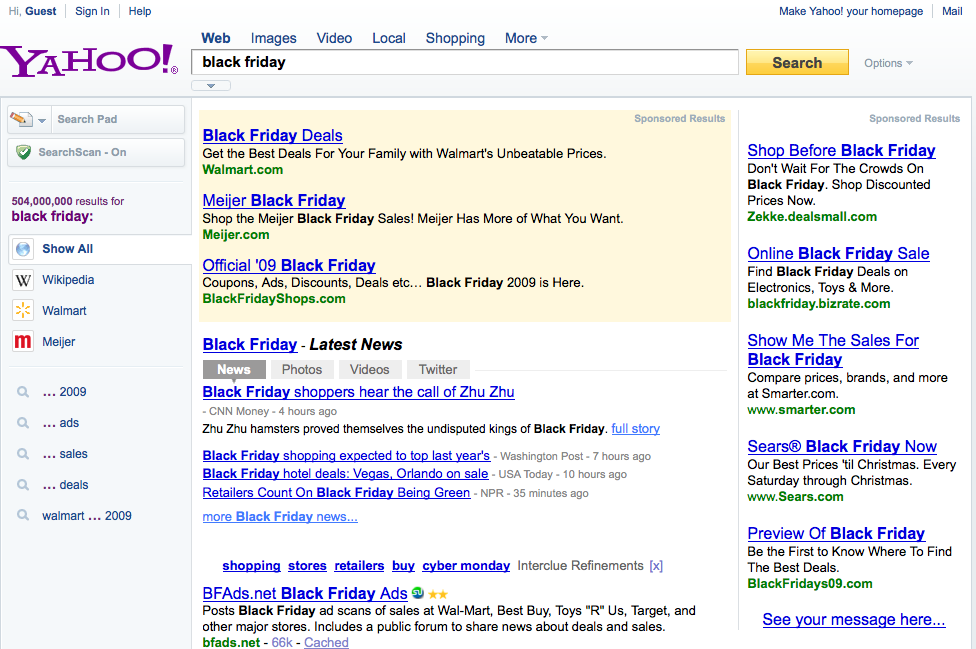
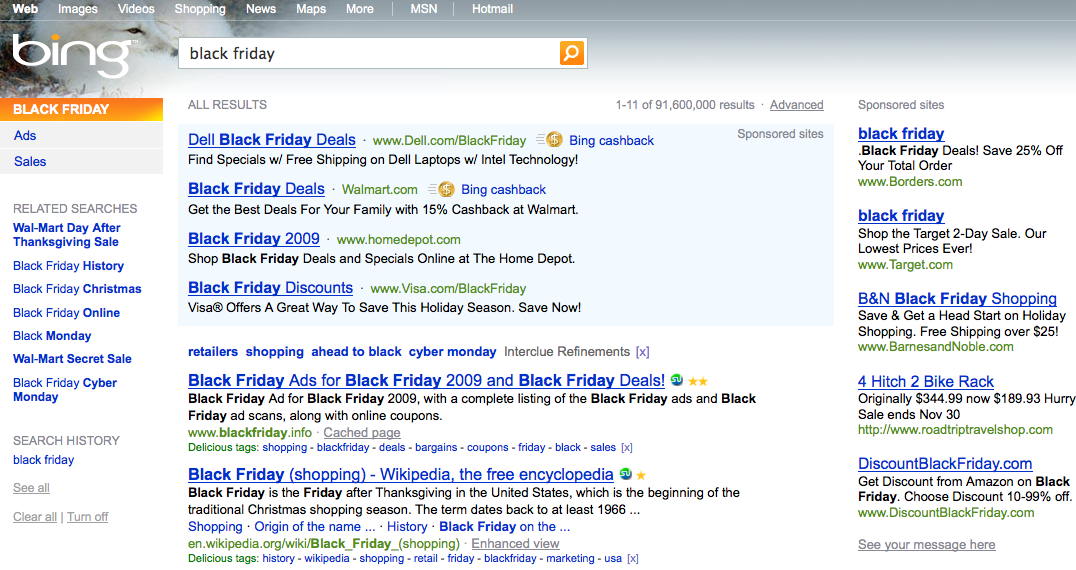
Some points of interest:
- Black Friday advertisements are largely dominated by big box retailers these days with very little action from local players, likely due to the cost to compete. Additionally, some Black Friday entrepreneurs (coupon sites, blogs, etc.), and odd-balls like Visa are advertising under the flag of "savings," have entered the conversation.
- Open competition exists between online only retailers like Dell and Amazon and multi-channel retailers, and the lines are blurring more than ever.
- Few are maximizing the budget they're spending online by implementing according to best practice, and creating relationships beyond Black Friday. The remainder of this post concentrates on opportunities to improve results.
The Post Click Experience
The largest opportunity for improvement across the board starts with the point of engagement, most commonly, the website. Few retailers go the extra mile to optimize the post click experience for their customers, ensuring relevance between the ad and the offer, and therefore maximizing results. Note this post will largely ignore impediments like requiring users to choose a store, or the balance between promoting online and offline sales realizing that these business decisions go beyond what we are able to examine from the outside.
Relevance to Black Friday - About half of the retailers above acknowledge that visitors came from a "Black Friday" related search phrase and ad, a start but too low. Example, Target takes the visitor to a page touting its "2 Day Sale." The urgency of Black Friday is not there, nor are any calls to action to purchase online. While spending across all sites, this is the effort that leaves the most to be desired.
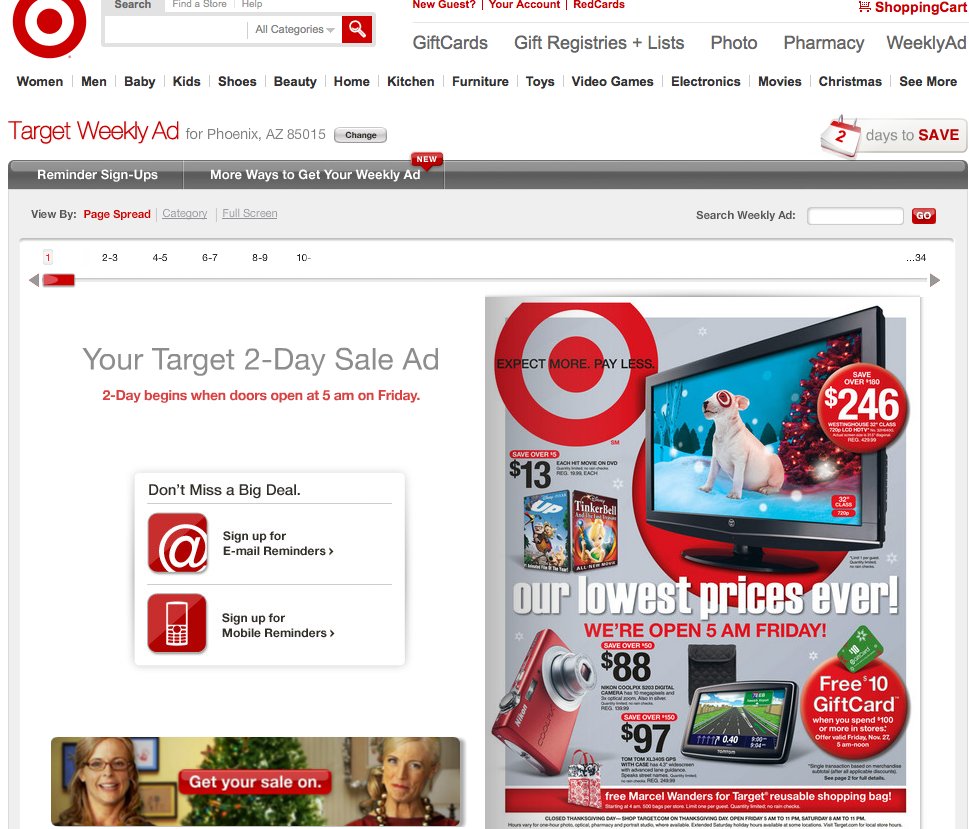
What I do like about Target's effort is the concentration on collecting contact info to further the conversation. Linking to social media outposts would have been wise, as would exposing the fields required to subscribe to Target's communications.
Call to Action, Creating Relationships Beyond Black Friday - Walmart does miss the opportunity to create a connection beyond picking a local store (email, social links, etc all can build relationships past this visit should a web visitor not purchase on or offline).
[caption id="attachment_86" align="alignnone" width="570" caption="Walmart Black Friday Landing Page 2009"]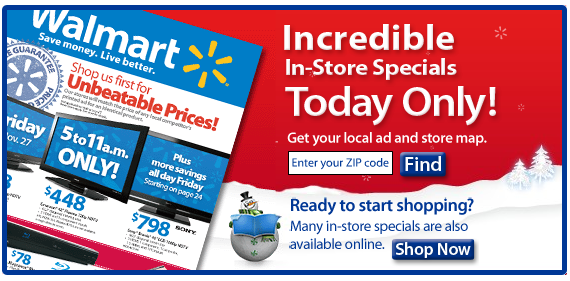 [/caption]
[/caption]
It should be noted that Walmart does have links to social media outposts, however, they exist near the bottom of the page and therefore may as well not exist.
Ease of Use - Others like Sears who create a great connection to products and the brand, unfortunately bombard the visitor with a non-consumable product listing page (see the craziness at here - below is one of three screen shots required to capture the page). I'd guess the bounce rate of this page to be equal to Target's if not higher.
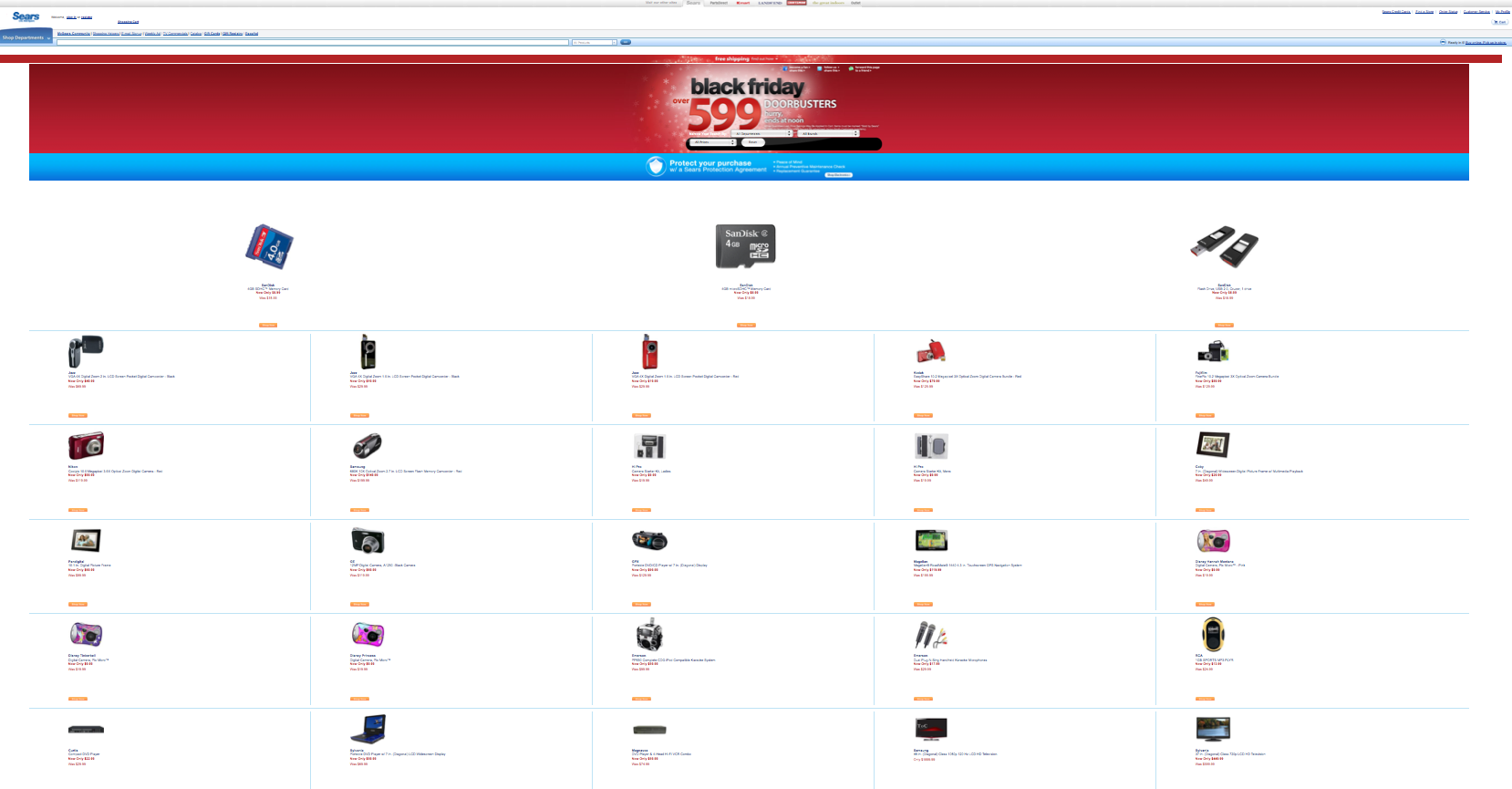
The Winner? - While far from perfect, the best multi-channel retail experience that I've seen thus far comes from JCPenney.
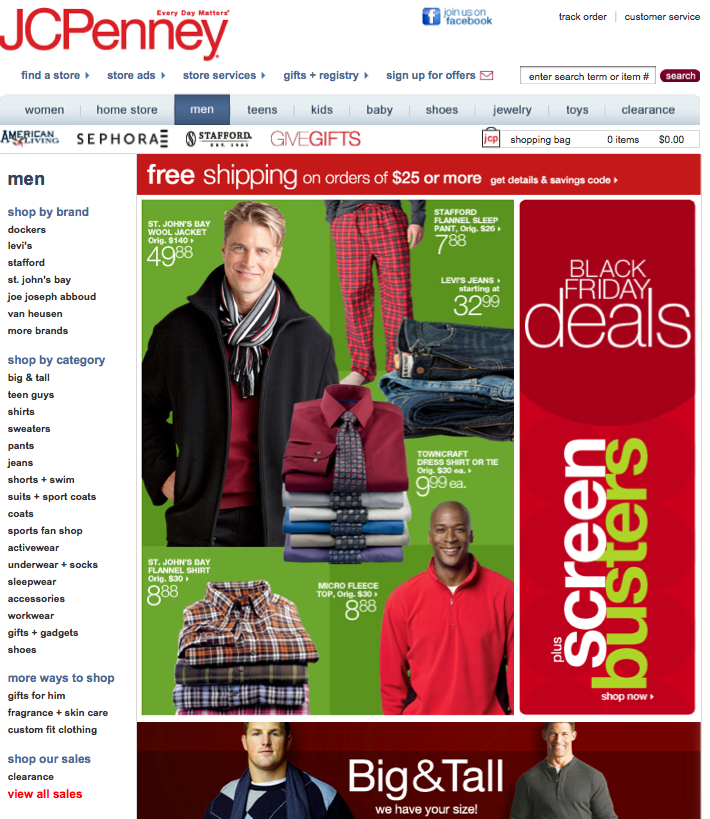
Driving store traffic is huge for most retailers believing you'll buy more than the sale you come to the store for - no argument - and JCPenney definitely provides information for users to make the connection. JCPenney however also understands that an online sale is valuable, and promotes them online with vigor, and links. As well, navigation exists to shop all deals, and links exist that allow visitors to connect with the brand in social media. The user experience is underwhelming visually, borrowing from print ads, but the info is there and ready for visitor action.
Of course, Dell and Amazon (who is leading the twitter buzz war per Mashable) are doing a great job and get it. Not unexpected, their business is online and their effort is superior, and frankly, easier to execute upon promoting a singular point of purchase. Amazon makes a quick connection to products and purchase, the name of their game, allowing their strong website to do the rest. Dell however goes the extra mile, allowing visitors to share their deals and connect via their strong social media presence.
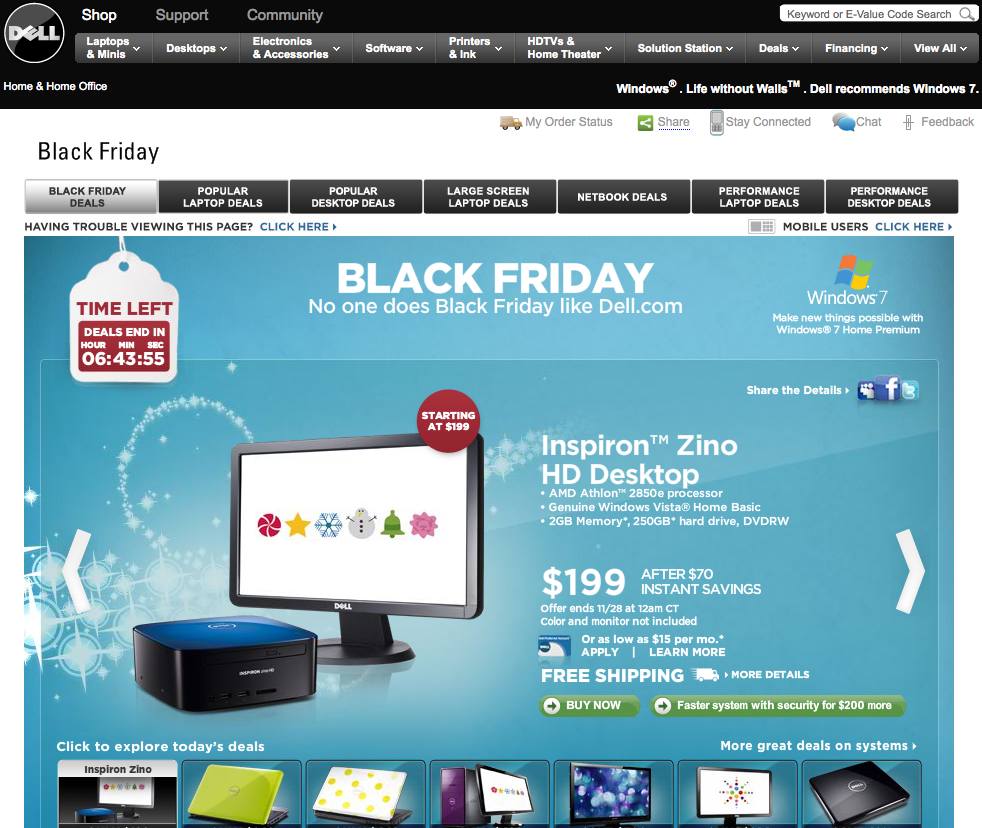
The lone knock on Dell? A visitor is forced to click on another ad on the Dell site prior to arriving here.
Creating One-to-One Relationships
Forget the sale today, the lifetime value of an engaged customer more often than not outweighs the short term profit sacrificed to begin a relationship. With a strong push for contact and interest acquisition while customer attention is high, it's quite possible that the brands listed could exceed their revenue totals from today through proper customer lifecycle marketing to these audiences over the next 12 months. Here's how:
Data Capture - Improving data capture is an opportunity for all advertisers mentioned in this post. Email and mobile are great opportunities to provide a subscriber the information they want at the time of need, with the later often being enough incentive to supply it. What about providing deeper savings to those already on the contact list as an incentive to sign-up?
Social Media - Social media provides a unique opportunity to bring actual brand and community interaction to the relationship building process. The social media possibilities could spawn five posts of their own as my notes go for miles, but a few tidbits:
- All retailers at this point should be allowing visitors to share the deals they are finding with their social networks using the method and outpost of their choice.
- Retailers should absolutely be promoting contact aggregation and membership in their social media programs at every turn in the communication cycle. On the topic, it's unbelievable to me that not a retailer on this list appears to be utilizing Facebook Connect to help the cause!
- Utilizing geo based applications like foursquare or GoWalla are no-brainers, and custom applications and widgets based on location could also be amazing. What if smart phone users could find special products and deals only known to them in-store using their devices? Augmented reality? Implementation is a real possibility, and not outrageously expensive.
Other Opportunities for Improvement
Search Engine Optimization - Given the media budgets spent today, it only makes sense that search engine optimization (SEO) be ephasized to lower the reliance on one-time spend. As far as I can tell, Black Friday isn't going anywhere, and a permenent, indexable presence wouldn't hurt. If an off-site permanent presence is preferred, procurement of an existing Black Friday site or URL would provide a buffer from the main site, and could be obtained for a similar budget to the media that is being spent.
Content Improvement - Across the board, it should be noted that quality content was completely absent, often times substituting offline ads for engaging and actionable copy, images and video. The most overlooked, and critical to conversion, strategic and engaging copy is proven to move the needle, and the user through the digital experience to the conversion desired.
Testing - If you're not testing, you're leaving money on the table, and the landing pages and ad copy reviewed today didn't seem all that dynamic. Even if your promotion is a day long, there's always opportunity to improve results, much of which can be done through automation.
Breaking the Mold - Just being different can often separate companies from the competition and create some much needed buzz, and digital couldn't be a more malleable implementation medium. Live inventory reports online by store? Local advertising online? Online product demos before Black Friday? Offers through new technology? Releasing products throughout the day with live messaging? The options are bound only by the imagination.
So how was your Black Friday experience in 2009? Were your expectations met? Are you expecting more from Cyber Monday?
[caption id="attachment_101" align="alignleft" width="56" caption="Mike Corak"] [/caption]
[/caption]
Mike Corak lead the strategic planning practice and account management efforts at the time of this post at Off Madison Ave, now performing similar tasks at www.tallwave.com, and is co-founder of www.digitalmarketingstrategy.com. An active member of the digital marketing community and frequent blogger and speaker, Mike's passion is interactive marketing. Mike's developed and implemented winning digital and integrated strategies for hundreds of companies over his 12 year career including the likes of Coca Cola, ConAgra Foods, ConocoPhillips, FedEx, Fujitsu, Nike, Office Depot, and Walt Disney. Contact Mike at mikecorak@gmail.com, or interact with Mike here: twitter, LinkedIn.














